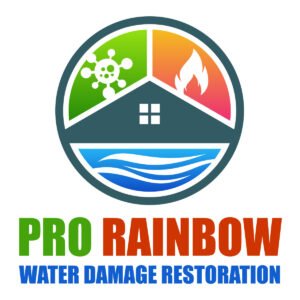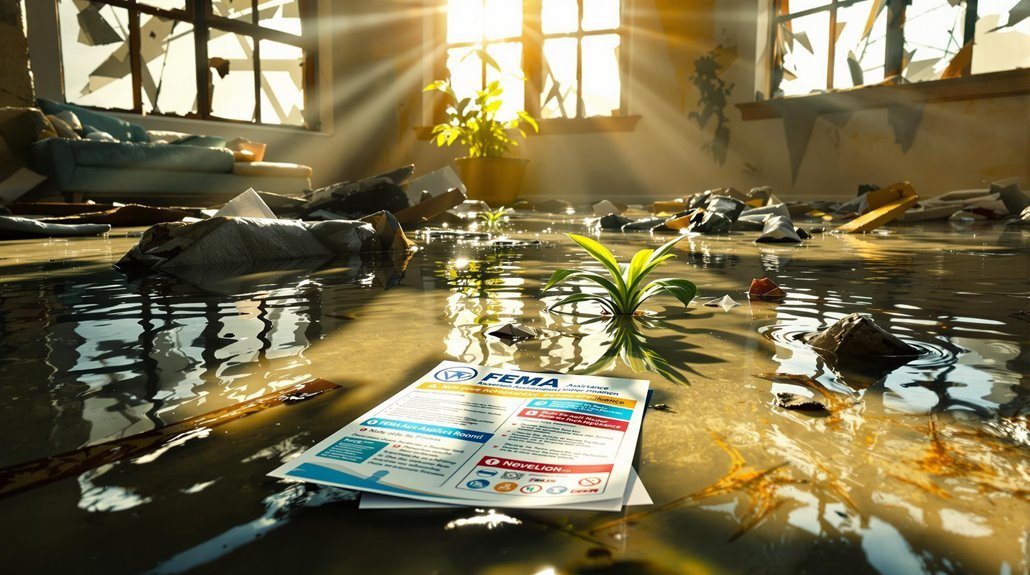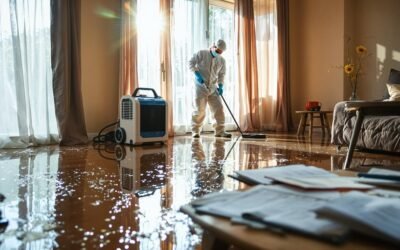If you're facing water damage from a disaster, FEMA disaster assistance can be crucial for your recovery. You must first verify your area is declared a disaster zone and gather the necessary documentation, like proof of identity, photos of the damage, and your insurance policy. FEMA provides aid to homeowners, renters, and businesses, regardless of whether you're underinsured. Remember to be aware of application deadlines to avoid delays and confirm you include all required information to prevent common mistakes. Stay organized throughout the process, and you'll find valuable insights that can further support your journey toward recovery.
Key Takeaways
- FEMA assistance requires that your area is declared a disaster zone, and the damage must be disaster-related.
- Essential documentation includes proof of identity, insurance details, photos of damage, and property ownership records.
- Applications can be initiated through the FEMA website or helpline; prompt submission is crucial to avoid delays.
- Missing deadlines can hinder your application; create a checklist to track important dates and reminders.
- Community resources and local organizations offer support, including food, shelter, and financial assistance for recovery efforts.
Understanding FEMA Assistance
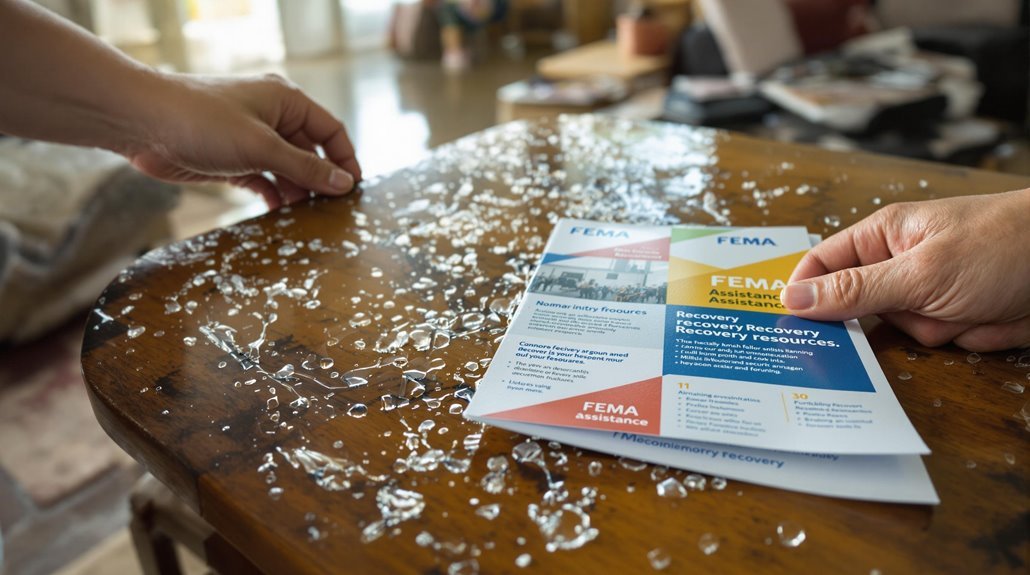
When disaster strikes, how do you navigate the complexities of FEMA assistance for water damage? Understanding FEMA programs is essential for effective disaster recovery. First, assess your situation and gather documentation, including photos and receipts. This evidence will support your application for aid. FEMA offers various assistance options—individual assistance for homeowners, renters, and specific programs for businesses affected by water damage. You'll want to apply online or through a FEMA representative to streamline the process. Remember, patience is key; it may take time to receive a response. In addition, familiarize yourself with deadlines and eligibility requirements to guarantee you don't miss out on the support you need. By staying organized and informed, you can successfully navigate FEMA's assistance options. Additionally, consider seeking professional water damage restoration services to help mitigate the impact of water damage on your property.
Types of Water Damage Covered
While water damage can stem from various sources, understanding which types are covered by FEMA assistance is crucial for your recovery. FEMA typically covers water damage caused by flooding, heavy rain, or storm surges, especially if you have flood insurance. This assistance can help with repairs and rebuilding efforts, ensuring you're not left to face the aftermath alone. Nevertheless, it's important to note that mold remediation isn't directly covered unless it's a result of a FEMA-approved disaster. As such, addressing mold quickly is critical for your health and safety. Professional restoration services can also aid in minimizing long-term issues related to water damage. Knowing what's covered will empower you to navigate the claims process better, providing peace of mind as you work toward restoring your home.
Eligibility Requirements
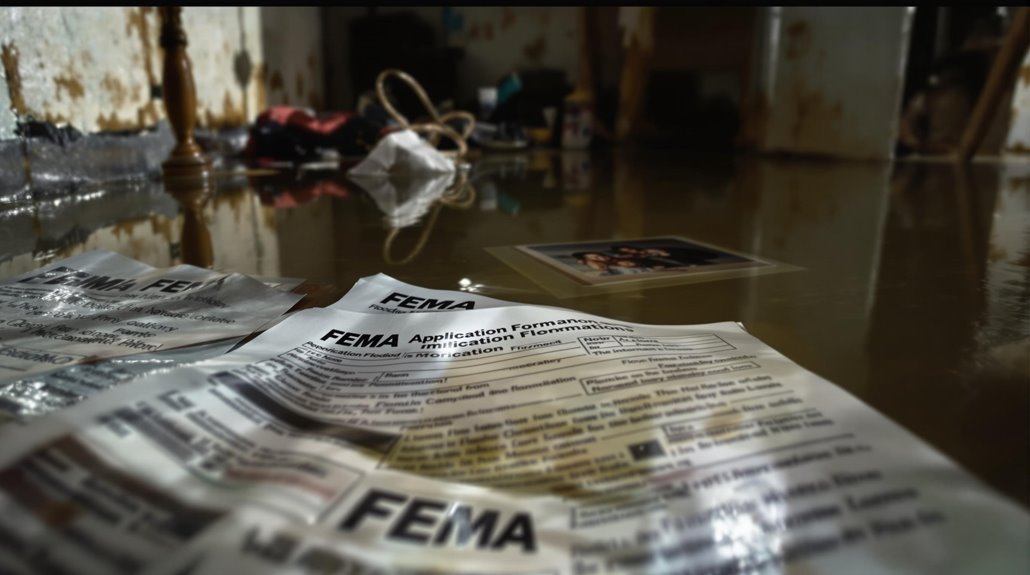
To qualify for FEMA disaster assistance following water damage, you must meet specific eligibility requirements that guarantee you receive the help you need. First, a water damage assessment confirms the extent of the damage. Then, you must meet these eligibility criteria:
| Criteria | Details |
|---|---|
| Location | Affected area must be declared a disaster zone. |
| Damage Type | Must be from a disaster-related event. |
| Homeownership | You must own or rent the damaged property. |
| Insurance Status | You may qualify regardless of whether you're underinsured. |
Understanding these criteria can ease the process and guarantee you secure the assistance necessary for recovery.
Application Process
Once you've confirmed your eligibility for FEMA disaster assistance, the next step is managing the application process. Start by visiting the FEMA website or calling their helpline for guidance. Be prepared to provide details about your situation, as this helps expedite your application.
Some application tips include keeping your information organized and submitting everything promptly to avoid delays. It's common to face challenges such as technical issues or understanding specific requirements, but don't hesitate to reach out for support. The process may feel overwhelming, but remember you're not alone. FEMA representatives can assist you, ensuring you have the best chance of receiving the assistance you need. Stay patient, and keep pushing forward.
Required Documentation
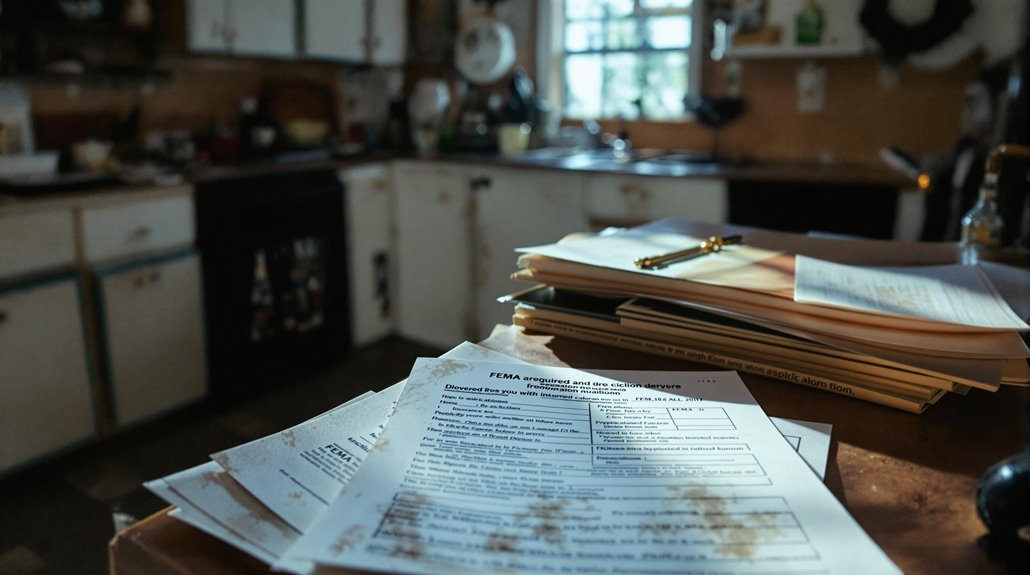
Gathering the right documentation is vital for a successful FEMA disaster assistance application. To streamline your process, create a documentation checklist that includes the following required forms:
- Proof of identity (e.g., driver's license, passport)
- Insurance policy details and claims
- Photos of the damage
- Property ownership documents (e.g., deed or mortgage)
- Any relevant repair estimates or invoices
Having these documents ready not only helps you fill out your application more efficiently but likewise supports your case for assistance. Remember, each form plays a significant role in demonstrating your needs. Take the time to verify everything's in order, and you'll be one step closer to receiving the help you deserve.
Financial Assistance Options
After you've collected all the necessary documentation, it's time to investigate the financial assistance options available through FEMA. If you have flood insurance, it's vital to file your claim promptly, as this can provide immediate relief for water damage. Nevertheless, if you don't have coverage, don't worry—FEMA offers recovery grants to help you rebuild. These grants can cover fundamental home repairs, temporary housing, and other disaster-related expenses. You'll need to apply through the FEMA website or by calling their helpline to access these funds. Remember, every situation is unique, so be sure to review your specific needs and eligibility. Understanding your options can markedly ease the recovery process and help you get back on your feet.
Temporary Housing Solutions

If you're facing temporary housing challenges after water damage, understanding your eligibility for assistance is essential. The application process can feel overwhelming, but knowing the steps can help you navigate it more smoothly. Let's examine how FEMA can support you during this difficult time.
Eligibility for Assistance
Have you found yourself in need of temporary housing because of water damage? Understanding your eligibility for assistance can be overwhelming, but it's crucial to know what to expect. FEMA offers help, but it varies by state regulations and available funding sources. Here are some key factors to reflect on:
- You must be a resident of the disaster area.
- Your home must be uninhabitable because of water damage.
- You need to provide proof of identity and residency.
- Temporary housing assistance is typically for a limited duration.
- Assistance may depend on your income and other personal circumstances.
These guidelines can help you navigate your options. Remember, you're not alone in this challenging time; resources are available to support you.
Application Process Steps
While maneuvering the application process for temporary housing solutions, it's important to stay organized and focused. Begin by gathering all necessary documentation, such as proof of damage, identification, and financial information. This preparation can save you time and prevent common pitfalls, like missing deadlines or submitting incomplete forms. When filling out your application, double-check for accuracy and clarity; errors can delay assistance. Consider reaching out to local agencies for additional application tips and support. They can offer valuable insights and help guarantee you're on the right track. Finally, keep track of your application status and follow up if you haven't received updates. Staying proactive will help you secure the assistance you need during this challenging time.
Home Repair Grants
When disaster strikes and water damage disrupts your home, you might not know where to turn for help, but FEMA's home repair grants can provide vital support. These grants are designed to help you recover financially while restoring your home. Here are some key points to take into account:
- Grants don't need to be repaid.
- They can cover important repairs to make your home livable.
- You'll need to document damage and expenses.
- Financial planning is essential to maximize your assistance.
- Don't hesitate to seek home repair tips from professionals.
Common Mistakes to Avoid
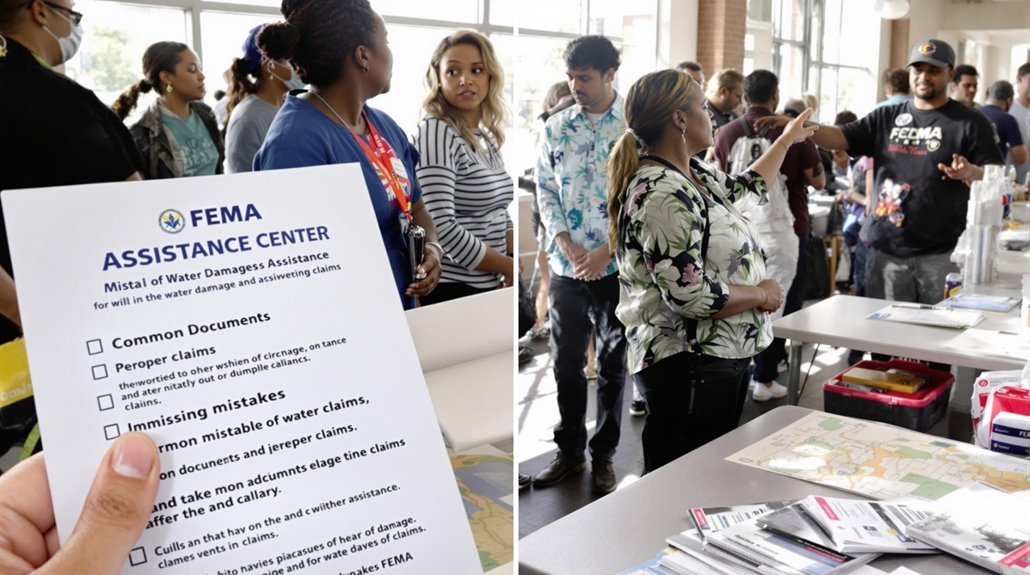
When you're maneuvering through FEMA disaster assistance for water damage, it's essential to avoid some common pitfalls. Missing documentation requirements can delay your application, while ignoring deadlines might result in missed opportunities for aid. Staying organized and proactive can greatly improve your chances of receiving the help you need.
Missing Documentation Requirements
Have you ever wondered why some disaster assistance applications get denied? A common reason is missing documentation. It's essential to understand these missing documentation challenges so you can avoid unnecessary setbacks. Here are some common mistakes to steer clear of:
- Not providing proof of ownership or occupancy
- Forgetting to include photos of the damage
- Failing to submit a detailed damage description
- Omitting financial information required for assistance
- Ignoring deadlines for documentation submission
Ignoring Deadlines and Timelines
While it might seem manageable to keep track of deadlines during a stressful recovery, ignoring them can lead to significant setbacks in your disaster assistance application. Understanding the deadlines' importance is vital; missing them can delay or even disqualify your request for aid. FEMA has strict timelines, and timeline management is fundamental for ensuring you provide necessary documentation and complete forms on time. Create a checklist with all relevant dates and set reminders to help you stay organized. Prioritize these tasks, as they directly impact your recovery process. By staying vigilant about deadlines, you'll improve your chances of receiving the assistance you need when you need it most. Don't let overlooked timelines hinder your recovery journey.
Timeline for Assistance
Understanding the timeline for FEMA disaster assistance is crucial, especially after experiencing water damage. Knowing what to expect can help ease your stress during this challenging time.
Here's a brief overview of the application timeline and assistance expectations:
- Initial registration: You should register as soon as possible after the disaster.
- Eligibility determination: Expect a response within 10 days.
- Inspection scheduling: FEMA usually schedules inspections within 1-2 weeks.
- Assistance notification: You'll receive a decision on your assistance within 2-3 weeks of inspection.
- Funds disbursement: If approved, funds can arrive within a few days after notification.
Additional Resources and Support
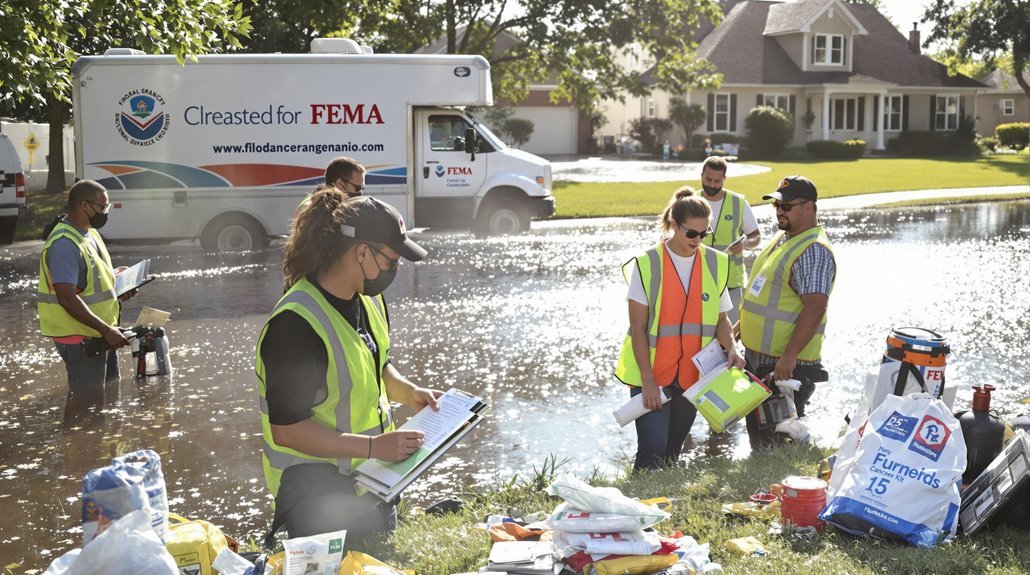
After experiencing water damage, you might feel overwhelmed and unsure about where to turn for help. Thankfully, there are community resources and support networks available to assist you during this challenging time. Local organizations often provide immediate relief, such as food and shelter, while others may offer financial assistance for repairs. Don't hesitate to reach out to your neighbors; they can be invaluable sources of information and emotional support. Furthermore, consider connecting with online forums or social media groups where you can share experiences and learn from others who've faced similar situations. Remember, you're not alone—tapping into these resources can help ease your burden and guide you toward recovery.
Conclusion
Maneuvering FEMA disaster assistance for water damage can feel overwhelming, but you're not alone. Many people have found themselves in similar situations, uncovering that help is just a few steps away. By understanding the types of water damage covered and ensuring you meet eligibility requirements, you can move forward with confidence. Remember, timely applications and accurate documentation make all the difference. As you take these steps, know that support is available to guide you toward recovery.
